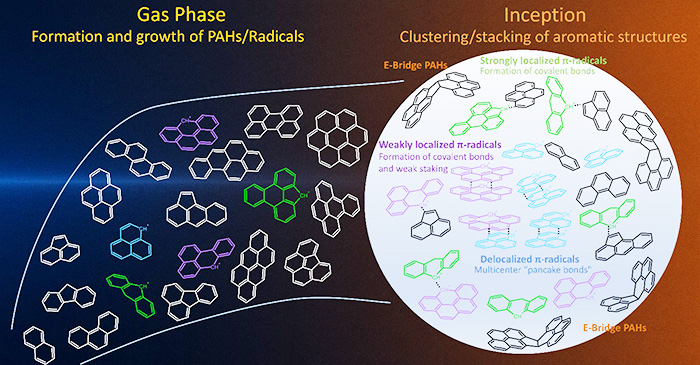The formation of soot particles during the incomplete combustion of fuels is both a major environmental challenge on Earth and a model system for understanding the formation of carbon grains in interstellar environments. Yet, the precise mechanism by which these solid particles emerge from gaseous molecules remains one of chemistry’s enduring mysteries.
Thanks to the DESIRS beamline, researchers from PC2A and IPR, in collaboration with the DESIRS-SAPHIRS team, have for the first time directly identified resonance-stabilized radicals involved in the formation of soot particles, shedding new light on this complex process.
Soot particles are formed during the incomplete combustion of hydrocarbon fuels, when the flame lacks sufficient oxygen to fully oxidize carbon. Initially invisible to the naked eye, they gradually form through the aggregation of aromatic molecules before becoming the tiny black grains responsible for a significant share of global air pollution. These particles have a major impact on both human health and climate, contributing to respiratory and cardiovascular diseases and intensifying global warming by absorbing sunlight.
Beyond our atmosphere, similar chemical processes also shape matter within interstellar clouds, where analogous carbonaceous particles, containing nearly 70% of the carbon found in space, form under comparable chemical conditions.
Understanding how these particles originate, both on Earth and in space, therefore means probing the same fundamental processes governing carbon chemistry. However, despite decades of research, the exact mechanism by which gaseous molecules assemble into the first solid particles remains a scientific enigma. This crucial step, known as nucleation, marks the transition from the gas phase to condensed matter.
Until now, the dominant theory has been based on the gradual growth of polycyclic aromatic hydrocarbons (PAHs) through the Hydrogen Abstraction–Acetylene Addition (HACA) mechanism. But this model struggles to account for soot formation in environments with few radicals or low acetylene concentrations.
Emerging evidence has suggested that resonance-stabilized aromatic radicals might play a key role: these molecules, both stable and highly reactive, could combine with PAHs without destroying their aromatic structure, leading to the first carbon aggregates.
This is precisely the area where researchers from PC2A and IPR, working with the DESIRS-SAPHIRS team at Synchrotron SOLEIL, have made a major experimental breakthrough.
By coupling a model methane flame with the double imaging photoelectron-photoion coincidence spectrometer (i2PEPICO) available on the DESIRS beamline, which enables mass-selected photoelectron spectra (PES) measurements, they directly observed and identified some of these aromatic radicals within the flame’s nucleation zone, where carbon particles are created. Notably, PES also allows the identification of isomers at a given mass, a crucial capability for analyzing such complex mixtures.

Figure 1: Selective identification of aromatic resonance-stabilized radicals by means of photoelectron spectra.
The detected species, including phenalenyl, 9-hydroanthracenyl, 7H-benzo[de]anthracenyl, and olympicenyl radicals, confirm the central role of these aromatic radicals in forming the first carbon aggregates. These results offer a new perspective on nucleation, revealing that soot formation may rely on complex radical chemistry involving both weak π–π stacking interactions and stronger covalent bonding.

Figure 2: Schematic illustration of possible soot particle inception pathways, tentatively highlighting the potential roles of resonance-stabilized radicals and PAHs in early particle formation.
Beyond applications in combustion modeling and pollutant emission reduction, this work also illuminates the chemical processes occurring in interstellar environments, where carbon grains that populate space are formed, thus linking terrestrial flames to the dust of the stars.
The next steps will aim to extend these observations to other flame regions in order to trace the evolution of these radicals during particle growth. Furthermore, upcoming improvements in the sensitivity and resolution of the i2PEPICO instrument will make it possible to identify even more short-lived species.
Ultimately, this research paves the way for a unified understanding of carbonaceous matter formation, from industrial flames to astrophysical environments. It also opens new perspectives for the development of predictive models of air pollution and for designing cleaner combustion processes.
